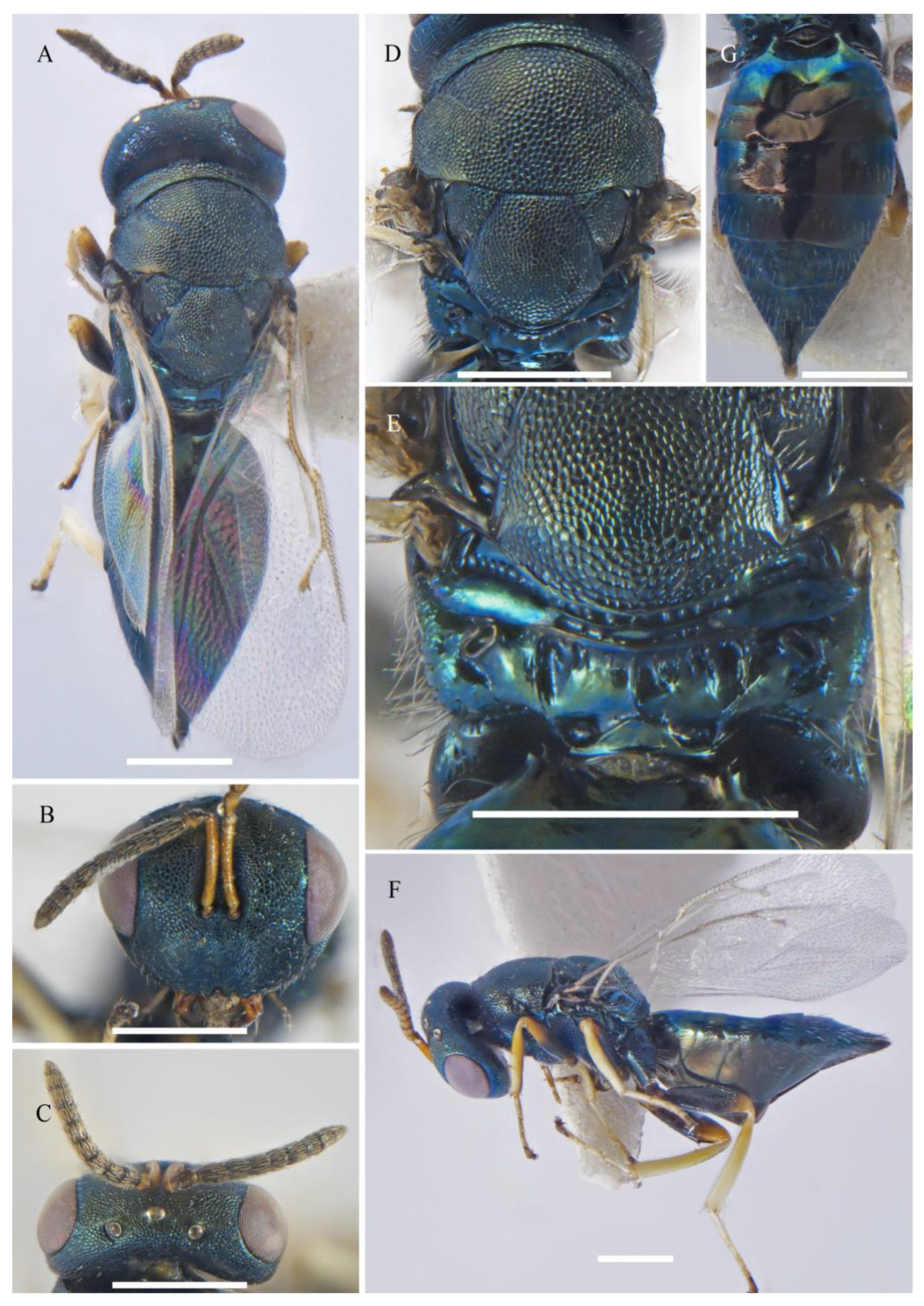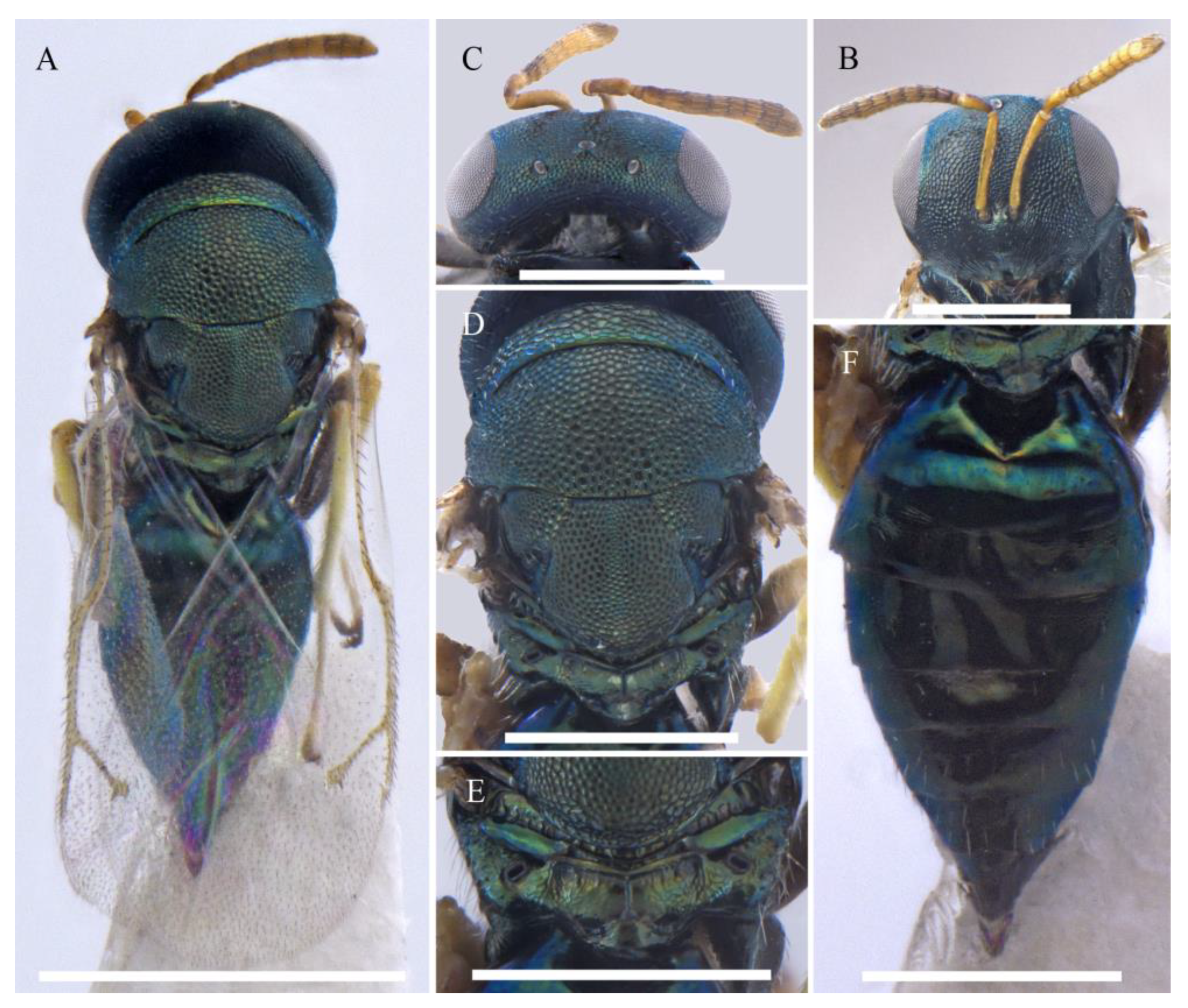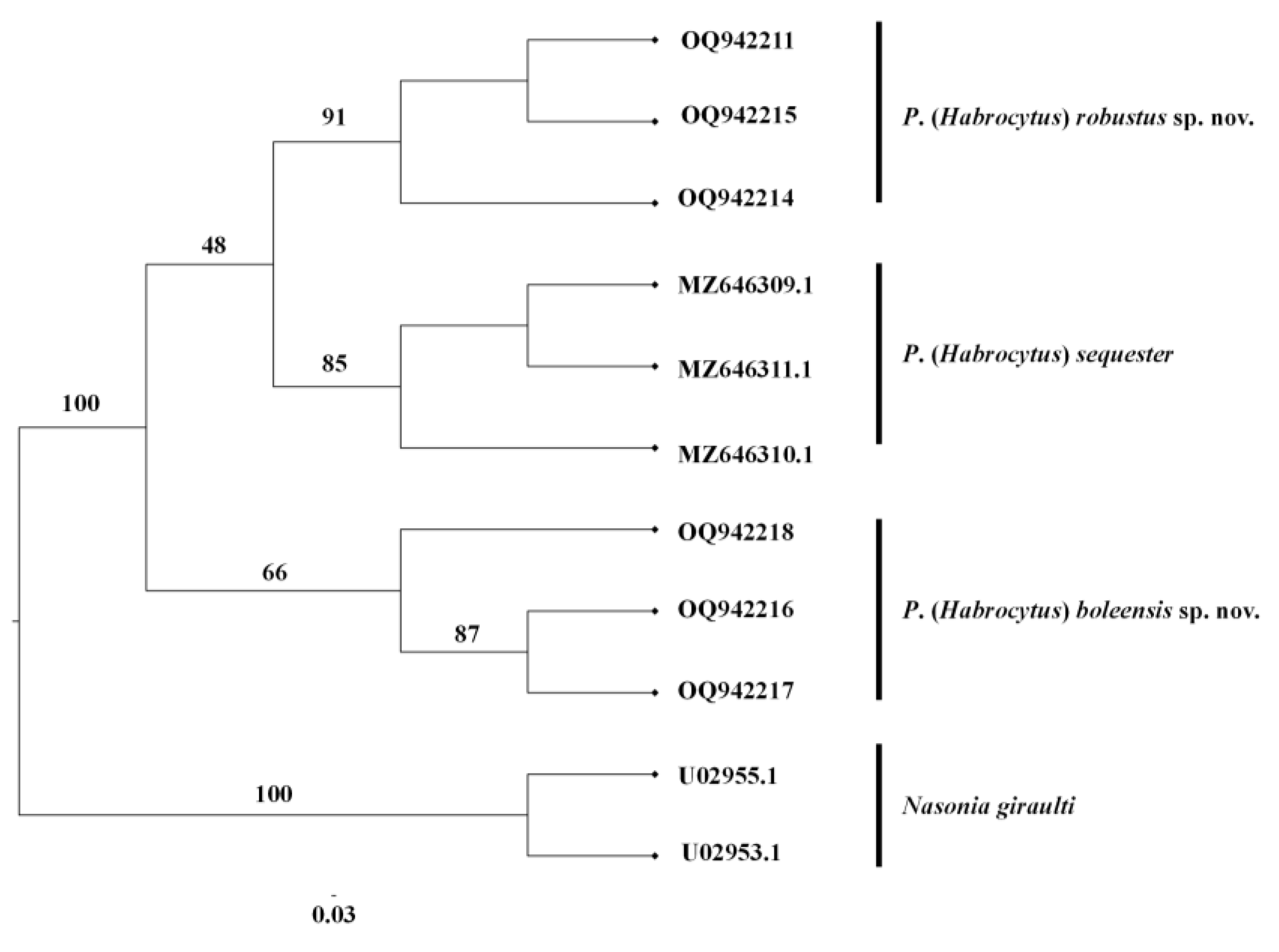3.1.2. Key to the world species of P. (Habrocytus) sequester group (females)
Propodeum with plicae as sharp carinae on the sides of nucha, and foveae at the base of propodeum, but effaced in the middle; flagellum stout, distinctly stouter proximally than pedicel in dorsal view; proximal segments of funicle subquadrate, distal segments at least slightly transverse .................................... P. (Habrocytus) cionobius (Erdös)
- -
Propodeum with plicae complete, sometimes not sharp in the middle but always distinct three; flagellum sometimes less stout; proximal segments of funicle sometimes slightly longer than broad .................................................................................................... 2
- 2.
Antenna with scape extending to the level of lower edge of median ocellus ............................................................................................................ P. (Habrocytus) sequester (Walker)
- -
Antenna with scape hardly extending to the level of lower edge of median ocellus...3
- 3.
Lower edge of torulus slightly above the level of ventral edge of eye; pedicel about 3.0× as long as first funicular segment; pronotal collar very long, medially 1/3 as long as mesoscutum ....................................... P. (Habrocytus) longepedicelus Yan et Li, sp. nov.
- -
Lower edge of torulus distinctly above the level of ventral edge of eye; pedicel at most 1.5× as long as first funicular segment; pronotal collar shorter, medially 1/7 to 1/4 as long as mesoscutum .............................................................................................................. 4
- 4.
Body size 2.2–2.8 mm; posterior margin of Gt1 at most slightly curving backwards but medially not produced; POL 2.0–2.4× OOL; metafemur about 4.1× as long as broad ............................................................................... P. (Habrocytus) boleensis Yan et Li sp. nov.
- -
Body size 3.1–3.5 mm; posterior margin of Gt1 curving backwards and strongly produced medially; POL 1.7–1.8× OOL; metafemur about 3.6× as long as broad .............................................................................................P. (Habrocytus) robustus Yan et Li sp. nov.
1. P. (Habrocytus) boleensis Yan et Li sp. nov.
Description. FEMALE (holotype,
Figure 1 A–F). Body length 2.8 mm. Body (
Figure 1A,F) metallic green with weak blue metallic reflections; eye bare; antenna brown except scape yellow; fore wing hyaline, veins brown; coxae identical to body in color; femora brownish-black, brown in apical sixth; tibiae slightly infuscate, apical tibial segments and tarsus white except apical tarsomere dark brown.
Head in frontal view (
Figure 1B) about 1.2× as wide as high; Antennal sockets slightly closer to anterior margin of clypeus than to median ocellus; scape short, 6.7× as long as broad, hardly extending to the level of lower margin of median ocellus; pedicel 2.0× as long as broad, 0.7× as long as fu1; funicular segments connected tightly to each other and each with 2 rows of sensilla; fu1 to fu5 about 1.2× as long as wide, fu6 as long as wide, clava about 2.5× as long as broad; pedicel and flagellum combined about 0.9× as long as head width. In lateral view, eye height about 1.6× eye width, malar space about 0.4× eye height. In dorsal view, head (
Figure 1C) about 2.3× as broad as long; POL about 2.0× OOL; temple about 0.3× as long as eye.
Mesosoma in dorsal view (
Figure 1D) as long as head width; pronotum collar slightly narrower than mesoscutum width (about 0.9×), pronotal collar medially 1/5 as long as mesoscutum; mesoscutum about 0.6× as long as broad. Propodeum (
Figure 1E) median area smooth, with a row of deep foveae at base, sides of propodeum smooth, about 0.3× as long as scutellum. In lateral view, prepectus about 0.7× as long as tegula; entire mesosomal pleura regularly reticulate except upper mesepimeron smooth. MV as long as PSV and about 1.4× as long as STV. Metacoxa in dorsal view bare, with fine reticulate sculpture, metafemur about 4.4× as long as broad.
Gaster (
Figure 1G) about 1.8× as long as broad, as long as head plus mesosoma; Gt1 smooth, with posterior margin obviously curved backward medially, about 0.3× as long as gaster.
Male. Unknown.
Diagnosis. Body smaller (2.2–2.8 mm); body metallic green with weak blue metallic reflections; fore wing veins brown; antennal sockets slightly closer to anterior margin of clypeus than to median ocellus; POL 2.0–2.4× OOL; propodeum with a row of deep foveae at base; posterior margin of Gt1 at most slightly curving backward but medially not produced; metafemur about 4.1× as long as broad.
Variation (paratypes, ♀). Body length 2.2–2.8 mm. Head in frontal view 1.2–1.25× as wide as high; pedicel and flagellum combined 0.83–0.85× as long as head width; malar space 0.4–0.5× eye height; head 2.3–2.5× as broad as long; POL 2.0–2.4× OOL; pronotal collar medially obviously narrower than mesoscutum width (1/7–1/5); mesoscutum about 0.6× as long as broad; scutellum about 0.9× as broad as long; MV 1.2–1.3× PSV; MV 1.5–1.6× STV; prepectus about 0.7× as long as tegula; metafemur about 4.1× as long as broad; gaster 0.95–1.0× as long as head plus mesosoma.
Remarks. The new species resembles sequester (Walker) but in general body shape and size. However, it can be distinguished from the existing species by the markings on its antennal sockets location, propodeum shape, and posterior margin shap of Gt1.
Etymology. The specific name is derived from the collection locality of its holotype.
Type material. Holotype f# [ICXU], air-dried on card point: China, Xinjiang, Bole, Alashankou-Tianshan route, sweeping on Asteraceae plants, 44°52'5.61"N, 82°2'45.65"E, 542 m, 26.vi.2022, Q. Li research group. Paratypes 21 f#, same data as holotype.
2. P. (Habrocytus) longepedicelus Yan et Li sp. nov.
Description. FEMALE (holotype,
Figure 2 A–F). Body length 2.3 mm. Body (
Figure 2A) metallic dark green with shine; eye bare; antenna bright yellow except pedicel, anelli and flagellum brownish-yellow; fore wing hyaline, veins pale brown; coxae identical with body color; femora brown, slightly brown in apical sixth; tibiae and white, telotarsi dark brown.
Head in frontal view (
Figure 2B) about 1.2× as wide as high; Antennal sockets (
Figure 2B) situated obviously closer to anterior margin of clypeus than to median ocellus; scape hardly extending to the level of lower margin of median ocellus; pedicel about 2.0× as long as broad, about 3.0× as long as fu1; funicular segments connected tightly to each other and each with 1 row of sensilla; fu1 to fu6 nearly as long as wide (2:2.3, 3:2.5, 3:3, 3:3, 3:3, 3:3), clava about 2.3× as long as broad; pedicel and flagellum combined about 0.8× as long as head width. In lateral view, eye height about 1.4× eye width, malar space about 0.5× eye height. In dorsal view, head (
Figure 2C) about 2.2× as broad as long; ocellus very small, POL about 1.8× OOL; temple about 0.5× as long as eye.
Mesosoma in dorsal view (
Figure 2D) narrower than head width (about 0.9×); pronotum collar slightly narrower than mesoscutum width (about 0.9×), pronotal collar very long, medially 1/3 as long as mesoscutum; mesoscutum about 0.53× as long as broad; scutellum with strong raised reticulate sculpture, about 0.95× as long as broad, frenal area absent. Propodeum (
Figure 2E) median area with slightly oblique rugae, sides of propodeum with irregular and weak rugae, about 0.5× as long as scutellum; nucha triangular and small. In lateral view, prepectus about 0.6× as long as tegula. MV about 1.9× as long as PMV and about 1.9× as long as the STV. Metacoxa in dorsal view bare, with fine reticulate sculpture, metafemur about 4.1× as long as broad.
Gaster (
Figure 2F) elongate, about 2.1× as long as broad, about as long as head plus mesosoma; Gt1 smooth, with posterior margin medially curved backward medially, about 0.6× as long as gaster.
Male. Unknown.
Diagnosis. Antennal sockets obviously closer to anterior margin of clypeus than to median ocellus; pedicel about 2.0× as long as broad, about 3.0× as long as fu1; funicular segments with 1 row of sensilla; fu1 to fu6 nearly as long as wide; ocellus very small; pronotal collar medially obviously narrower than mesoscutum width (nearly 1/4–1/3); propodeum median area with slightly oblique rugae, sides of propodeum with irregular and weak rugae.
Variation (paratypes, ♀). Body length 2.41–2.42mm. Head in frontal view about 1.0–1.2× as wide as high; malar space about 0.48–0.54× eye height; head about 2.1–2.3× as broad as long; POL about 1.7–1.9× OOL; pronotal collar medially obviously narrower than mesoscutum width (nearly 1/4–1/3); mesoscutum about 0.66–0.70× as long as broad; scutellum about 1.0–1.1× as broad as long; MV 1.67–1.68× PSV; MV 1.67–1.68× STV; prepectus about 0.6–0.7× as long as tegula; gaster elongate about 0.9–1.2× as long as head plus mesosoma.
Remarks. The new species resembles P. (Habrocytus) sequester (Walker), both green with golden reflections; proximal segment is slightly longer than broad; propodeum median carina and plica complete, median area usually smooth. P. (Habrocytus) longepedicelus sp.nov. differs from P. (Habrocytus) sequester (Walker) by the following characters: Antennal sockets obviously closer to anterior margin of clypeus than to median ocellus (Antennal sockets obviously closer to median ocellus than to anterior margin of clypeus); Pedicel 3.0× as long as fu1(Pedicel 1.2× as long as fu1); funicular segments with 1 whorl of sensilla (funicular segments with 2 rows of sensilla); ocellus very small (ocellus is smaller than P. (Habrocytus) longepedicelus sp.nov.).
Etymology. The specific name refers to the long pedicel of the holotype.
Type material. Holotype f# [ICXU], air-dried on card point: China, Xinjiang, Emin County, sweeping on Poaceae, 46°21'43.91"N, 83°53'17.52"E, 645 m, 28.vi.2021, Q. Li research group. Paratypes 1f#, air-dried on card point: China, Xinjiang, Tekes County, 43°9'19.98"N, 81°47'23.76"E, 1184 m, 9.vii.2021, Q. Li research group; 1f#, air-dried on card point: China, Xinjiang, Fuyun County, 47°0'53.64"N, 89°32'4.90"E, 1360 m, 11.vii.2020, Q. Li research group.
3. P. (Habrocytus) robustus Yan et Li, sp. nov.
Description. FEMALE (holotype,
Figure 3 A–E). Body length 3.0 mm. Body (
Figure 3A,E) metallic bright green with shine; eye bare; antenna pale brown except scape and pedicel yellow; fore wing hyaline, veins white; coxae identical with body color; femora dark brow in basal 2/3 white, femora brown with basal, ventral margin 2/3 and apical 1/3; tibiae and tarsus white; telotarsi dark brown.
Head in frontal view (
Figure 3B) about 1.3× as wide as high, face with metallic reflections and regularly raised reticulations; anterior margin of clypeus deeply emarginate in the middle. Antennal sockets (
Figure 3B) situated closer to clypeus anterior of margin than to median ocellus; scape short, 7.0× as long as broad, hardly extending to the level of lower margin of median ocellus; pedicel about 1.5× as long as broad, about as long as fu1; funicular segments connected tightly to each other and each with 2 rows of sensilla; fu1 to fu3 about 1.3× as long as wide, the following three funicular segments about 0.80× as long as wide, clava about 2.0× as long as broad; pedicel and flagellum combined about 0.76× as long as head width. In lateral view, eye height about 1.4× eye width, malar space about 0.7× eye height. In dorsal view, head (
Figure 3C) about 2.5× as broad as long; POL about 1.7× OOL; temple about 0.3× as long as eye.
Mesosoma in dorsal view (
Figure 3A), narrower than head width (about 0.8×); pronotum slightly narrower than mesoscutum width (about 0.9×), ponotal collar 1/5 as long as mesoscutum; mesoscutum about 0.7× as long as broad; scutellum with strong raised reticulate sculpture, about 1.0× as long as broad, frenal area absent. Propodeum (
Figure 3D) median area smooth, with a row of shallow foveae at base, sides of propodeum median area smooth, about 0.4× as long as scutellum. In lateral view, prepectus about 0.5× as long as tegula. MV about 1.3× as long as PMV and about 1.5× as long as STV. Metacoxa in dorsal view bare, with fine reticulate sculpture, metafemur about 3.6× as long as broad.
Gaster (
Figure 3A) about 1.8× as long as broad, about 1.0× as long as head plus mesosoma; Gt1 smooth, with posterior margin obviously curved backwards medially, about 0.4× as long as gaster.
Male. Unknown.
Diagnosis. Body larger (3.1–3.5 mm); body metallic bright green with shine, veins white; the antennal sockets slightly closer to anterior margin of clypeus than to median ocellus; POL 1.7–1.8× OOL; Gt1 with posterior margin obviously curved backward medially.
Variation (paratypes, ♀). Body length 3.0–3.5 mm. Head in frontal view about 1.2–1.3× as wide as high; pedicel and flagellum combined about 0.7–0.8× as long as head width; malar space about 0.4–0.5× eye height; head about 2.3–2.4× as broad as long; POL about 1.7–1.8× OOL; pronotal collar medially obviously narrower than mesoscutum width (1/5–1/4); mesoscutum about 0.61–0.63× as long as broad; scutellum about 0.87–0.91× as broad as long; MV 1.0–1.1× PSV; MV 1.3–1.4× STV; prepectus about 0.70–0.72× as long as tegula; gaster elongate about 1.1–1.2× as long as head plus mesosoma.
Remarks. The new species strong resembles that of
boleensis sp. nov. but is larger (3.0–3.5 mm). Through the integrative taxonomy based on DNA barcoding and morphological evidence, the result showed that
P. (
Habrocytus)
robustus sp. nov. is a valid species (
Figure 4).
Etymology. The specific name refers to the body of this species being robust.
Type material. Holotype f# [ICXU], air-dried on card point: China, Xinjiang, Tacheng Perfecture, Tacheng City, sweeping on Poaceae, 46°43'2.69"N, 83°4'12.54"E, 544 m, 23.vi.2022, Q. Li research group. Paratypes 11 f#, air-dried on card point: China, Xinjiang, Kizilsu Kirgiz Autonomous Prefecture, Atushi City, sweeping on Poaceae plants, 39°43'23.03"N, 76°9'4.76"E, 1349 m, 28.vii.2022, Q. Li group; 2m# [ICXU], air-dried on card point: China, Xinjiang, Ili Kazakh Autonomous Prefecture, Xinyuan County, sweeping on Medicago or Salvia, 43°24'12.16"N, 83°34'53.73"E, 1044 m, 11.vii.2021, Q. Li research group.








